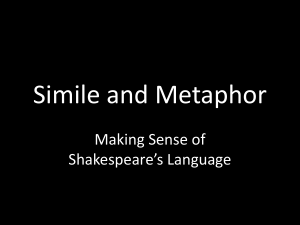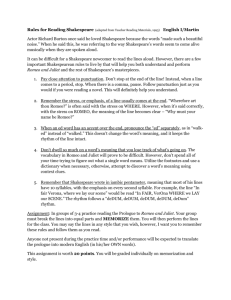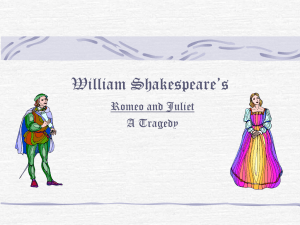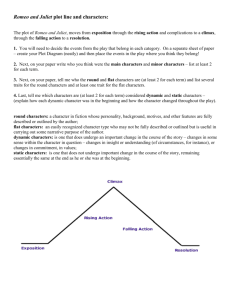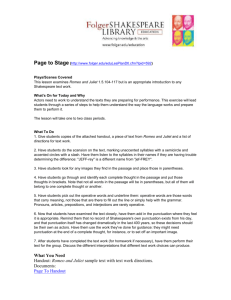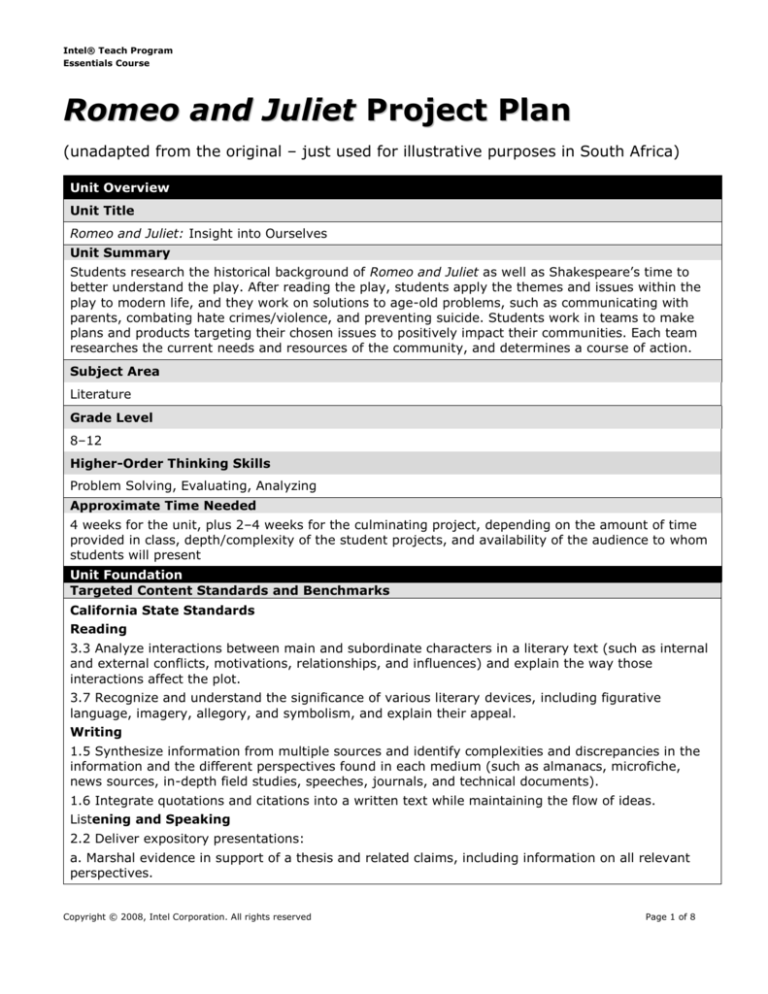
Intel® Teach Program
Essentials Course
Romeo and Juliet Project Plan
(unadapted from the original – just used for illustrative purposes in South Africa)
Unit Overview
Unit Title
Romeo and Juliet: Insight into Ourselves
Unit Summary
Students research the historical background of Romeo and Juliet as well as Shakespeare’s time to
better understand the play. After reading the play, students apply the themes and issues within the
play to modern life, and they work on solutions to age-old problems, such as communicating with
parents, combating hate crimes/violence, and preventing suicide. Students work in teams to make
plans and products targeting their chosen issues to positively impact their communities. Each team
researches the current needs and resources of the community, and determines a course of action.
Subject Area
Literature
Grade Level
8–12
Higher-Order Thinking Skills
Problem Solving, Evaluating, Analyzing
Approximate Time Needed
4 weeks for the unit, plus 2–4 weeks for the culminating project, depending on the amount of time
provided in class, depth/complexity of the student projects, and availability of the audience to whom
students will present
Unit Foundation
Targeted Content Standards and Benchmarks
California State Standards
Reading
3.3 Analyze interactions between main and subordinate characters in a literary text (such as internal
and external conflicts, motivations, relationships, and influences) and explain the way those
interactions affect the plot.
3.7 Recognize and understand the significance of various literary devices, including figurative
language, imagery, allegory, and symbolism, and explain their appeal.
Writing
1.5 Synthesize information from multiple sources and identify complexities and discrepancies in the
information and the different perspectives found in each medium (such as almanacs, microfiche,
news sources, in-depth field studies, speeches, journals, and technical documents).
1.6 Integrate quotations and citations into a written text while maintaining the flow of ideas.
Listening and Speaking
2.2 Deliver expository presentations:
a. Marshal evidence in support of a thesis and related claims, including information on all relevant
perspectives.
Copyright © 2008, Intel Corporation. All rights reserved
Page 1 of 8
Intel® Teach Program
Essentials Course
b. Convey information and ideas from primary and secondary sources accurately and coherently.
Copyright © 2008, Intel Corporation. All rights reserved
Page 2 of 8
Intel® Teach Program
Essentials Course
Student Objectives/Learning Outcomes
Students will be able to:
Understand and interpret the use and purpose of figurative language, imagery, and wordplay in
Romeo and Juliet.
Analyze the relationships among the main and supporting characters of Romeo and Juliet and
how their interactions affect the plot.
Analyze the actions, themes, and social issues of the play in order to identify issues that are still
relevant today.
Conduct research on issues of concern to the community and gather, evaluate, and synthesize
data from a variety of sources to communicate their discoveries in ways that suit their purpose
and audience
Use a variety of electronic and print resources to gather and synthesize information and to create
and communicate knowledge to a specific audience
Curriculum-Framing Questions
Essential
How does literature help us better understand ourselves?
Question
Unit
Questions
Content
Questions
Does fate control people’s lives?
How does Shakespeare still speak to a 21st century audience?
What is imagery, and what are some examples of how Shakespeare uses
imagery in Romeo and Juliet to present a compelling and powerful
message?
What are the themes and issues in Romeo and Juliet that are relevant to
today?
Student Assessment Plan
Assessment Summary
Use questioning throughout the unit to assess students’ understanding of the Curriculum-Framing
Questions as well as other important questions about the play. Determine students’ background
knowledge and help them think about what they already know about Shakespeare and Romeo and
Juliet with the Venn diagram and the K-W-H-L chart. As students complete character blogs while
studying the play, ask them to use the blog rubric to guide their work. Review the reading response
periodically to assess students’ understanding as well as redirect teaching if necessary.
Ask students to use the action plan to help guide them through the stages of brainstorming,
planning, and implementation of their plans as well as part of a final assessment of their work.
Students also use the project scoring guide to support the creation of their presentations.
Hold teacher and peer conferences to provide feedback before the final presentations are completed.
Have students use the peer feedback form to record feedback and assist in improving their projects.
Use the project scoring guide to assess the culminating projects, with adjustments to the group
scores based on individual efforts and contributions. Assess students’ contributions to the final
discussion regarding the Essential Question, How does literature help us better understand
ourselves?
Copyright © 2008, Intel Corporation. All rights reserved
Page 3 of 8
Intel® Teach Program
Essentials Course
Assessment Timeline
Before project work begins
Questioning
K-W-H-L
Chart
Venn Diagram
Reading
Response
Journals
Students work on projects
and complete tasks
Questioning
Reading
Response
Journals
Blog Rubric
Action Plan
Teacher
Conferences
Peer Feedback
Form
After project work is
completed
In-class
Essay
Scoring
Guide
Reading
Response
Journals
Reflections
Unit Details
Prerequisite Skills
Basic research
Internet
Computer skills
Instructional Procedures
Beginning of the Year
Introduce a discussion about why people like a good story. How does writing about characters help
them “come alive” off the page? What kind of characters can students identify with? What do stories
do for us anyway? Next, introduce and discuss the Essential Question that will be used all year, How
does literature help us better understand ourselves? Talk about how the units that will be studied this
year will help the class answer the Essential Question.
As a whole class or in small groups, ask students to think about the differences and similarities
between classic and contemporary literature by filling out the Venn Diagram. Conduct a whole class
discussion about the value of classic literature and why students read it.
Reading Romeo and Juliet
As a whole class, fill out the first three columns of the K-W-H-L chart to help students access their
prior knowledge and provide useful information about student attitudes and possible misconceptions.
Continue the discussion about where students see Shakespeare’s influence in today’s world. Read the
Passage by Bernard Levin* about the influence of Shakespeare on our everyday speech. Explain how,
in this unit, they will work to answer the Unit and Essential Questions, along with learning to
appreciate—or at least understand—Shakespeare’s most famous play, Romeo and Juliet.
Briefly explain that the students will be completing a project where they will apply the themes and
issues within the play to address a current-day problem along with real solutions.
Ask students to use the Internet to find information about Shakespeare, his time, and Elizabethan
Copyright © 2008, Intel Corporation. All rights reserved
Page 4 of 8
Intel® Teach Program
Essentials Course
theater and share what they have learned with the class on chart paper, or through a blog or wiki.
Some notable online resources are Shakespeare Resource Center* and Shakespeare's Theatre*.
Introduce the reading response journal to students. These journals give students a place to document
reading, record thoughts and responses to important questions, and cite examples of literary terms.
Some students may want to keep their response journals in the form of a blog. Students may also
choose the option of keeping a blog from the point of view of one of the characters. See Juliet’s Blog
for an example. Review the blog rubric with students to help guide their work. Collect journals on a
weekly basis to assess students’ understanding of terms. Use this information to guide and redirect
teaching as needed.
Before students begin to read the play, model different strategies for interpreting and understanding
Elizabethan language. Assign parts for reading the beginning of Act I of the play aloud with the whole
class. Throughout the unit, to engage students and address different learning styles, alternate the
methods in which students are exposed to the play: whole class and small group oral reading,
individual silent reading, audio recording, and video.
Introduce literary terms, such as pun, foreshadowing, and soliloquy, as appropriate throughout the
reading of the play and ask students to record examples and illustrations of these terms in their
response journals and discuss them in large and small groups. Model the kind of literary analysis you
expect from students as they think about the play.
The following questions can serve as a starting point for discussions about the play:
How do the metaphors help to paint a picture of characters’ states of mind?
How does imagery and figurative language affect how we judge the intentions or inclinations of
characters?
How does the use of imagery add to the mood of the scene?
How does the imagery affect the way we respond to the scene?
Periodically, throughout the study of the play, ask students to discuss the Essential Question: How
does literature help us better understand ourselves? in their journals and in large- and small-group
discussion as it relates to their personal interpretation of Romeo and Juliet.
After students have completed the play, ask students what fate is. Pose the question, Do you believe
in fate? Discuss the idea of fate, as understood in the time of Shakespeare. Ask where fate intervenes
in the play. Discuss a quote from another play that shows a different look at fate that admits that
what happens to us may have more to do with our own shortfalls than fate:
The fault, dear Brutus, is not in our stars,
But in ourselves, that we are underlings.
Julius Caesar
Have students record their thoughts on this question in their reading response journals. In small
groups, have students discuss their opinions on fate and give examples of fate in their own lives or in
other literary examples or movies.
To ensure that students have thought deeply about the play, assign an in-class, open-book essay, in
which students reflect on the play and apply their understanding of the characters, plot, and themes
of the play to their lives. Part of this essay should address the Essential Question: How does literature
help us better understand ourselves?
To prepare for the culminating project, ask students to brainstorm a list of social issues which appear
in the play that are relevant to contemporary life.
Culminating Project
Review the list of the brainstormed social issues and ask students to rank them by their importance to
people of all ages in their community. You may ask students to use the Visual Ranking Tool to create
Copyright © 2008, Intel Corporation. All rights reserved
Page 5 of 8
Intel® Teach Program
Essentials Course
their prioritized lists and compare their ideas with those of other community members.
Discuss the culminating project in detail in which students apply the themes and issues within the play
to modern life and work on solutions to age-old problems. Tell students they will present their findings
and solutions to an appropriate audience and create appropriate products to supplement their
message, such as a multimedia presentation, brochure, newsletter, flyer, or wiki. Examples include
the following:
Students research community resources for teen suicide and create a brochure of warning
signs to look for, where to get help, and so forth. They then create and present their findings
to a particular audience—peers, parents, or other community members. Pamphlets go to
attendees but also to counselor offices and student centers.
Students research Internet sites, interview experts, and read books to find ways for parents to
communicate better with their teenagers. They create a presentation and skit to be presented
to parents at a parent meeting, open house, or other gathering.
Students research Internet sites and books to find ways to prevent violence in their
community. They form a club and create a wiki* to be presented to their peers, parents, and
community members at a community meeting.
Assign groups and ask them to brainstorm issues, formats, and audiences for their project. Discuss
the components of an action plan and ask students to create an action plan to guide them as they
work on the project. The action plan template may help some students with special needs organize
their work. Refer to the suicide prevention action plan as an example. Explain that this document is a
working document that will help through the brainstorming, planning, and implementation stages of
the plan to make a difference in the school, community, or even the world.
During the research phase, have students keep track of their resources while they research the
current needs of the community and determine a course of action. Some students may need to use
the research form to help them stay organized as they work. Discuss the minimum requirements for
research when completing the accompanying products (brochures, presentations, wiki, and so forth).
Provide the project scoring guide at the beginning of the project so students can self-assess as they
present their message and associated products.
Show samples of student projects to give students a sense of the content, but do not spend too much
time on any of the samples. A brochure template is available for students who need extra guidance,
but students should be encouraged to develop their own unique ideas to help solve difficult problems.
As the project progresses, meet periodically with each group to review their action plan to ensure they
are on track. Have each group turn in their completed action plan, which includes an assessment of
individual contributions along with any associated materials they created to support their
presentation. After student groups meet with you individually, have groups meet with each other to
receive feedback. Ask students to use the peer feedback form.
After all teams have presented to their respective audiences, provide a class session—or an evening
meeting when parents and administration can attend—for students to discuss their experiences, what
they presented, and how their message was received. Finalize the project discussion by allowing
students to reflect on the Essential Question, How does literature help us better understand
ourselves?
Accommodations for Differentiated Instruction
Copyright © 2008, Intel Corporation. All rights reserved
Page 6 of 8
Intel® Teach Program
Essentials Course
Special Needs
Student
Nonnative
Speaker
Gifted/Talented
Student
Provide templates for some of the associated products, such as a
brochure template
Provide fill-in-the-blank plot worksheets to help the student simplify
and identify the characters and action
Allow the student to choose the method and tools for the culminating
project that draw upon on the student’s strengths
Provide a parallel text of Romeo and Juliet in the student’s first
language whenever possible or use a modern English version of the
text
Allow the culminating project to include some content in the student’s
first language if it meets the needs of the audience the student is
trying to reach
Use some of the scaffolds created for the resource student, such as
the fill-in-the-blank plot worksheets, if appropriate
Emphasize that the culminating project provides a wide range and
choice of community projects and outreach that would specifically
draw upon the strengths of the gifted student
Encourage the student to look beyond the obvious and come up with
creative solutions for difficult problems
Copyright © 2008, Intel Corporation. All rights reserved
Page 7 of 8
Intel® Teach Program
Essentials Course
Materials and Resources Required For Unit
Technology – Hardware (Click boxes of all equipment needed)
Camera
Laser Disk
VCR
Computer(s)
Printer
Video Camera
Digital Camera
Projection System
Video Conferencing Equip.
DVD Player
Scanner
Other
Internet Connection
Television
Technology – Software (Click boxes of all software needed.)
Database/Spreadsheet
Image Processing
Web Page Development
Desktop Publishing
Internet Web Browser
Word Processing
E-mail Software
Multimedia
Other
Encyclopedia on CD-ROM
Printed Materials
Text of Romeo and Juliet, preferably with footnotes to define archaic words
Supplies
Shakespeare’s Grammar
www.bardweb.net/grammar/04gloss.html*
Glossary search
Shakespeare Help
www.shakespearehelp.com/romeo/main.htm*
Internet Resources
Information about Romeo and Juliet
American Foundation for Suicide Prevention
www.afsp.org*
Information, activities, news stories, and policies aimed at preventing
suicide
Other Resources
*Legal Information | Privacy Policy
* Copyright © 2008 Intel Corporation. are All rights reserved. Intel, the Intel logo, Intel Education,
and the Intel Teach Program are trademarks of Intel Corporation in the U.S. and other countries.
*Other names and brands may be claimed as the property of others
Page 8 of 7




